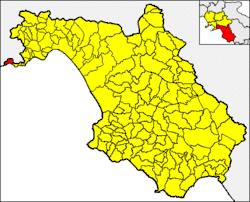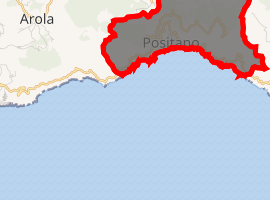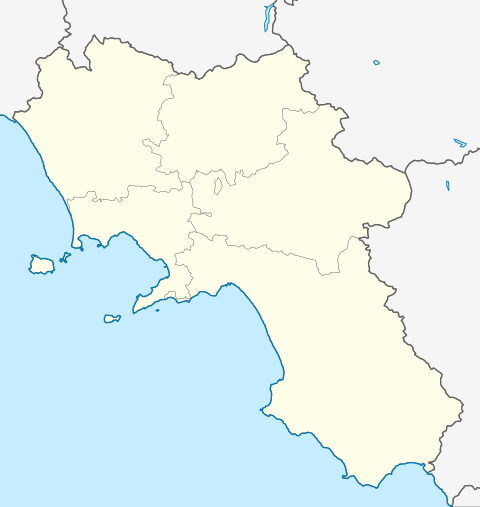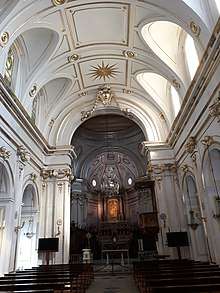Positano
Positano (Campanian: Pasitano) is a village and comune on the Amalfi Coast (Province of Salerno), in Campania, Italy, mainly in an enclave in the hills leading down to the coast.
Positano | |
|---|---|
| Comune di Positano | |
View of Positano at sunset | |
 Positano within the Province of Salerno | |
Location of Positano 
| |
 Positano Location of Positano in Italy  Positano Positano (Campania) | |
| Coordinates: 40°38′N 14°29′E | |
| Country | Italy |
| Region | Campania |
| Province | Salerno (SA) |
| Frazioni | Montepertuso, Nocelle |
| Government | |
| • Mayor | Michele De Lucia |
| Area | |
| • Total | 8.65 km2 (3.34 sq mi) |
| Elevation | 0 m (0 ft) |
| Population (31 December 2017)[2] | |
| • Total | 3,913 |
| • Density | 450/km2 (1,200/sq mi) |
| Demonym(s) | Positanesi |
| Time zone | UTC+1 (CET) |
| • Summer (DST) | UTC+2 (CEST) |
| Postal code | 84017 |
| Dialing code | 089 |
| Patron saint | St. Vitus |
| Saint day | June 15 |
| Website | Official website |
Climate
The climate of Positano thanks to its position is very mild, of the Mediterranean type; the winters are very warm with minimum temperatures that almost never fall below 6 degrees, while the summers are long, warm and sunny but often refreshed by the sea breeze. Thanks to the mild temperature and the beauty of the landscape, Positano has been a holiday resort since the time of the Roman Empire, as evidenced by the discovery of a villa in the bay. Typical are the many staircases that from the top of the village connect the upper districts with the valley area. The main beaches are Spiaggia Grande, Fornillo, La Porta, Fiumicello, Arienzo, San Pietro, Laurito and Remmese, some of which can also be reached by sea.
History
Positano was an essential stop for the ancient Greeks and Phoenicians on their expeditions to western areas. It is said that the coastal village was named after Poseidon, God of the Sea.
Like many other places along the beautiful campanian coast, it was a favourite site for wealthy ancient Romans to build rich and grand villas, one of which lies below the church of Santa Maria Assunta and has recently been opened to the public.[3]
Positano became a wealthy market port from the 15th to 17th century and has only continued to grow in popularity over time. Back then they traded food such as fish and other resources.[4]
Positano was a port of the Amalfi Republic in medieval times, and prospered during the sixteenth and seventeenth centuries. By the mid-nineteenth century, however, the town had fallen on hard times. More than half the population emigrated, mostly to America.
Positano was a relatively poor fishing village during the first half of the twentieth century. It began to attract large numbers of tourists in the 1950s, especially after John Steinbeck published his essay about Positano in Harper's Bazaar in May, 1953: "Positano bites deep", Steinbeck wrote. "It is a dream place that isn’t quite real when you are there and becomes beckoningly real after you have gone."[5]
Main sights

The church of Santa Maria Assunta features a dome made of majolica tiles as well as a thirteenth-century Byzantine icon of a black Madonna.[6] According to local legend, the icon had been stolen from Byzantium and was being transported by pirates across the Mediterranean. A storm had blown up in the waters opposite Positano and the frightened sailors heard a voice on board saying "Posa, posa!" ("Put down! Put down!"). The icon was unloaded and carried to the fishing village and the storm abated.
The Marina Grande beach is at the base of the cliff side town of Positano and is the most recognized beach in the town. Other popular beaches include Fornillo beach and Arienzo beach.[7]
Culture
Positano has been featured in several films, including Only You (1994), and Under the Tuscan Sun (2003), as well as more recently in Kath & Kimderella (2012) and being mentioned in the 2009 musical film Nine in the song "Cinema Italiano". It has also hosted the annual Cartoons on the Bay Festival, at which Pulcinella Awards for excellence in animation are presented.[8]
From July 1967 and through most of the 1970s, Positano was home to singer-songwriter Shawn Phillips and where most of his best-known work was composed. Mick Jagger and Keith Richards from The Rolling Stones wrote the song "Midnight Rambler" in the cafes of Positano while on vacation.
Renowned director and producer Franco Zeffirelli owned the Villa Treville in Positano, where he took residence over a 35-year period and hosted a coterie of literati and stars of the stage and screen. He hired his friend, Renzo Mongiardino, who collaborated on many of his theater and opera projects, to design the exquisite interiors which reflect the local design sensibilities and craftsmanship. The Villa Treville has since been converted into a five-star boutique hotel.[9]
German pianist Wilhelm Kempff made Positano his summer retreat and there he taught a summer course on the Beethoven piano sonatas and concerti. Since his death in 1991, the Beethoven Kurse has continued under the organization of the Wilhelm Kempff Kulturstiftungng, having had as teachers Gerhard Oppitz and John O'Conor. Today tourism is by far the major industry. Positano is also very popular for Limoncello and "L'Albertissimo", an alcoholic tipple that can only be found at a small stall at the main harbor.
The town's rapid growth from a small fishing village to an international destination is credited to the rise of the tourism industry. In addition to the beaches, cliffs, and historic sites, clothing stores and restaurants are scattered throughout Positano, attracting tourists from around the world. To complete the picture, natural lemon, orange, and olive groves grow prominently across the cliffside town. The produce is often sold in fresh markets around the city.[4]
Transportation
Positano can be reached by the SS163 Amalfitana national road, or by the SP425 provincial road.
The nearest airports are the Napoli-Capodichino (NAP) and the Salerno-Pontecagnano Airport (QSR) and they have shuttle buses to destinations across the Amalfi Coast, including Positano.[4]
Ferries link Positano to other towns including Capri, Naples, Salerno, and Sorrento for transportation.[4]
The Sita bus links Positano to Amalfi and Sorrento. [10]
See also
- Li Galli
- Amalfi Coast
- Sorrentine Peninsula
References
- "Superficie di Comuni Province e Regioni italiane al 9 ottobre 2011". Istat. Retrieved 16 March 2019.
- "Popolazione Residente al 1° Gennaio 2018". Istat. Retrieved 16 March 2019.
- "Roman Villa of Positano finally opens to the public".
- "Information on Positano, Italy".
- "Positano". www.amalficoast.com.
- "Santa Maria Assunta in Positano". Retrieved 19 April 2012.
- "Positano".
- "CARTOONS ON THE BAY: A 'LA FAMIGLIA SPAGHETTI' IL PULCINELLA D'ORO PER LA SERIE TV". e-duesse.it (in Italian). 13 April 2003. Archived from the original on 2017-12-11. Retrieved 29 May 2020.
- "Villa Treville: Heritage". Villa Treville. Retrieved 6 August 2015.
- "2020 Bus schedules for the Amalfi Coast - Sita Positano Amalfi". Positano.com. Retrieved 2020-02-27.
External links
| Wikimedia Commons has media related to Positano. |
| Wikivoyage has a travel guide for Positano. |
- Official website
- Positano online newspaper about Positano, the Amalfi Coast, Sorrento, and Campania in general
- Positano Premia La Danza
- Positano Travel Guide
- Timetable ferry for Positano
- Positano.com